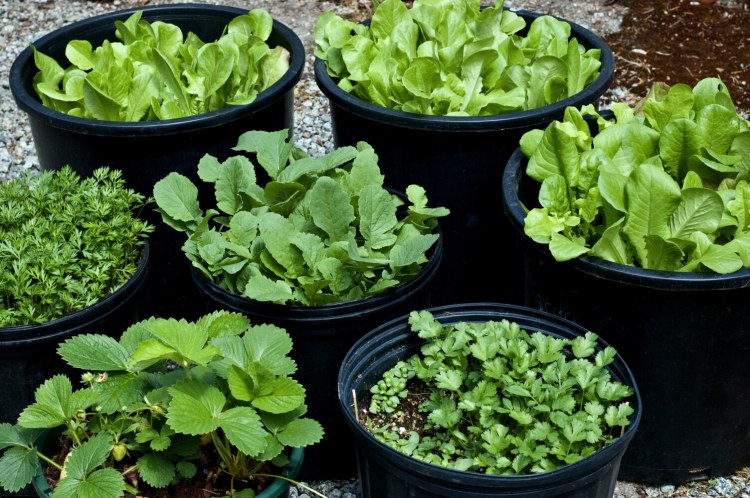Vegetable gardening is a trend again. Some people see shortages at grocery stores, and they want to make sure they have good, fresh food to eat and perhaps stretch their budgets. Others are just stuck home and bored, looking for an activity that is more productive than streaming videos.
People with a little bit of land can convert some of it to vegetable gardening fairly easily. But for those without available land, because they live in apartments or have too much shade, there are containers.
A container can be almost anything, from the bottom half of gallon milk jug to a raised bed. It can be the nursery pot your pine tree came home in, a five-gallon pail that once contained driveway sealer, chicken wire lined with newspaper or – for traditionalists – a flower pot bought specifically for the purpose.
If the container doesn’t have holes in the bottom, make some. Drainage is important. Depending on what the container is made from, you can drill holes or hammer a nail through the bottom. Do not think that you can put rocks or Styrofoam peanuts in a container without drainage holes and grow good vegetables.
Bigger is better. The cut-off milk jug lets people grow tiny crops of beets, carrots, Swiss chard or loose-leaf lettuce. You can grow more of all of those in the large pots, but the crop options also expand. One website I came across said corn is possible in a five-gallon pail: three stalks, or six ears, only, and it’s difficult. I wouldn’t recommend it.
After the pots, comes soil. Don’t use soil from any gardens you or your neighbors have. Garden soil is too heavy for use in pots, doesn’t drain well, dries out and forms a brick-like consistency. It also contains weed seed.
At this difficult time, I like helping out Mainers, so buy a Maine product if you can. Coast of Maine creates a number of soil mixes; Bar Harbor Blend is the most popular. But just now, you are probably going to be getting soil from your local nursery via curbside pickup, so trust the nursery and take what its workers recommend.
What you grow depends on two things: What you like to eat and how much of a challenge you want.
Easy plants that can be planted as soon as you finish reading this column (and you have your seeds ready) include beets, carrots, chard, radishes, lettuce, onions and peas. Late this month or early June, plant cucumbers, tomatoes, peppers, eggplant and beans.
The roots of these plants will need space. For tomatoes, peppers, squash, cucumbers, eggplant, broccoli and Brussels sprouts, plan on one plant for each container, and the container should be close to five gallons. For other crops, give each seed a couple inches of space. The seed packet will say how far apart the seeds should be, and the same rules apply in pots as in the ground.
For the one-plant-per-pot crops, buy seedlings rather than seeds – the exception perhaps being summer squash, which we have successfully grown from seed. Farmers markets and farm stands are considered essential so are open despite the pandemic, providing plenty of distancing. They are great sources for vegetable seedlings. Though the seed business is booming, many seed stores still have some vegetable seeds available; there might be delays from mail-order companies.
All vegetables like full sun. Pick the sunniest spot you can find for your crops. If that is the driveway or walkway, so be it. The few times that you are actually leaving your property these days, just be super-careful not to run over the pots.
Water regularly. Containers dry out more quickly than soil in a traditional garden. During hot and dry spells (yes, I swear 2020 will have some, although this spring doesn’t support that theory), daily watering will be required.
Use liquid fertilizer weekly. Bill Kinney of Allen, Sterling & Lothrop, in a talk earlier this spring, recommended Jack’s Professional Fertilizer, which used to be called Peter’s but got a name change. But it’s a crisis. If what you can find is Miracle-Gro, use it and follow the label instructions.
Remember, the plants can and will expand beyond the pot. Beans, peas, cucumber and squash like to climb. Set up a trellis or other support system above those crops and let them grow tall. It will increase production a lot. Cherry-sized tomatoes do well in hanging baskets, trailing over the sides of the pot, being ornamental as well as productive.
For those worried about fending off starvation, I have three suggestions. Surprisingly, one of them is not potatoes, which kept the Irish alive for generations and which have plenty of local ties. They aren’t highly productive in pots. I’ve tried and failed.
Rather, I suggest green beans, zucchini and tomatoes. They all can become very tall with support, which increases yield.
Zucchini’s fecundity is the subject of jokes, but people will be home and able to prevent the squashes from reaching the size of baseball bats; the squash vines will keep growing until frost.
Green beans also produce high yields, and picked young are quite tasty. If you leave them on the vine too long, you may still be OK, as many varieties can be used as dried beans.
Tomatoes are also productive. And a ripe, slicing, home-grown tomato is what summer is all about. I’m going to revel in huge, red, juicy tomatoes to offset everything else we are sacrificing.
Tom Atwell is a freelance writer gardening in Cape Elizabeth. He can be contacted at: tomatwell@me.com.
Send questions/comments to the editors.


